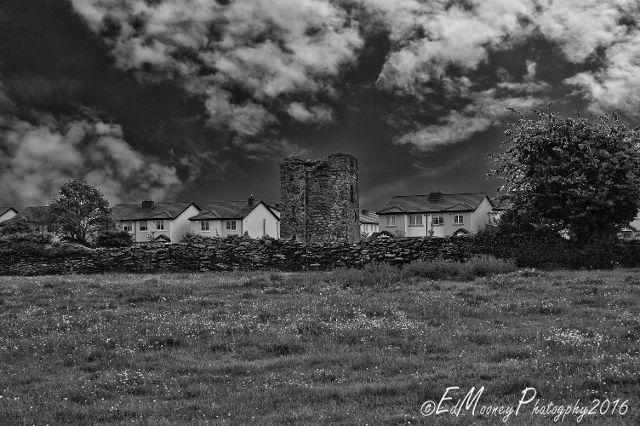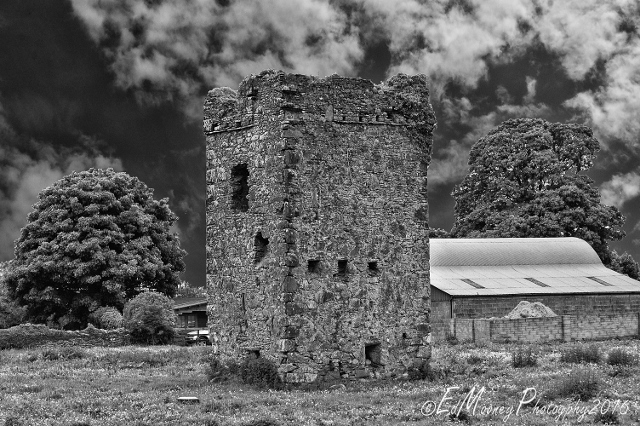This lonely Tower house sits in a field to the west of Jigginstown House which I spoke about a few weeks ago. It dates back to the early part of the 15th century and is typical of the many Fortified tower houses built along the outskirts of the Pale in order to defend the Norman centre of influence in Dublin and the surrounding counties. Most of these where built as a result of a grant of £10 from Henry VI. It was actually quite commonplace for merchants to construct such castles and the town of Naas had at least eight of these within its walls with another six on the outskirts. Castle Rag was one of two such Tower houses said to have been in the possession of Roland FitzEustace back in 1486. We don’t know for sure if he built them or was granted them, but considering that in 1474 he was one of the founding members of the Brotherhood of Saint George, a military order charged with the defence of the Pale, He is more than likely responsible for their construction.
Roland was an interesting character, born the son of Sir Edward FitzEustace, the lord Deputy of Ireland. In 1462 he was elevated to the Irish peerage as Baron Portlester and went on to become Lord Chancellor of Ireland and Lord Treasurer of Ireland by Edward IV of England in 1474. It was during this time that he was accused of Treason against the Crown, but it is said that he defended himself with such vigour that all the charges were dropped. In 1478 his son-in-law, Gerald FitzGerald, 8th Earl of Kildare, was replaced as Lord Deputy of Ireland by Henry Grey, (Baron Grey of Codnor), to which Portlester organised a campaign of non-cooperation with the new Deputy. When Grey ordered him to hand over the Great Seal of Ireland, Portlester refused, which made the conduct of official business impossible.
Henry VI went to considerable lengths to support Grey, and even ordered the Master of the Royal Mint in Ireland, to strike a new Great Seal, declaring that the Seal held by Portlester was annulled, and that all acts passed under it under it were utterly void; but this did not work as planned and after a few months Lord Grey was forced to return back to England a failure. FitzEustace was reappointed Chancellor by Henry VII, but removed yet again, for the part he played in the crowning of Lambert Simnel, as King Edward VI of England, in 1487. This coronation took place in Christ Church Cathedral, Dublin and was attended by almost every noble and Prince in Ireland. After the defeat of Simnel at the battle of Stoke, Henry was now secure on his throne, but pardoned FitzEustace and his peers. Roland remained an influential figure for the remaining decade of his life, and was able to fight off an attack on his record as Treasurer in 1493.
The Tower house is on private lands and has a number of horses grazing nearby, so I didn’t chance entering to have a look around without permission, hopefully I will be able to track down the owner in the near future and get access. It is a small two-storied structure which is accessed via a partially robbed-out doorway in the east wall. There are parapets and a slightly projecting stairs at the north angle which are built of rough rubble and limestone masonry with large, well-dressed quoins (corner stones). The walls taper inwards slightly towards the top, under which beam-slot holes mark the floor line of a loft, which is lit by narrow loops in the east and west walls. The narrow spiral stairs is accessed through a plain, square-headed doorway in the N corner and is lit between ground and first-floor levels by a loop window and a slightly larger rectangular window to the north. Between the first-floor and parapet level by a rectangular window in the east and another loop to the west. The first floor is said to be entered through a plain square-headed doorway in the north corner. The floor is lit by two large opposing square-headed windows with traces of window seats in the east and west walls, there is also a blocked loop is visible in the south wall. A robbed-out fireplace with red brick mantle-supports resides in the north wall with a chimney that projects from the outer wall supported on two corbels. The battlement level is inaccessible, but lower courses of crenulations and gutters survive on the projecting parapet. Aside from St. David’s Castle in Naas town which I have also yet to explore, this is the last standing castle of its kind in the area. Although from the outside it appears to be in relatively decent condition would be a crime to allow it to end up like the dozen or so neighbouring Tower houses which once stood nearby.
For these and more of my images, why not visit my Website







Excellent bit of history!
LikeLiked by 1 person
Cheers Rajiv 🙂
LikeLike
Great photos!
LikeLiked by 1 person
Thanks Daniel 😁
LikeLike
Love that last shot, Ed!
LikeLiked by 1 person
Nice piece of history but definitely NOT an enticing abode. Can’t imagine spending any amount of time inside!
LikeLiked by 1 person
Really, I would love something like this👍
LikeLike
Unlike Noelle, I wouldn’t mind one, perhaps as a weekend retreat! Thanks for the history and the photos too, Ed. Great stuff as always. (You could do a lot with £10 in those days…)
Best wishes, Pete.
LikeLiked by 1 person
Me too, it would be great and the wife would never come near it, she hates places like that. It would be the ultimate man shed 😁
LikeLike
It’s very severe, isn’t it, and so Irish? There are lots of castles like these in Ireland, not much more than a clown or tower. Some great research there too, and a few familiar names reappearing there! Great post, Ed. 😀
LikeLiked by 1 person
Yeah, these guys tend to be involved in everything during the medieval period, Rock stars of the time 🙂
LikeLiked by 1 person
I love that description of them, Ed! 😁
LikeLiked by 1 person
They got up to more trouble than Led Zepplin and the Rolling Stones put together in a hotel room with a case of Bourbon and a bag of drugs 🙂
LikeLiked by 1 person
Oh my word that bad, eh??? Hahaha! 😁😂😄😅
LikeLiked by 1 person
LOL Keith Richards would have learned a thing or two from them medieval chaps 🙂
LikeLiked by 1 person
Like Ali, it looks very severe and odd against the backdrop of the newer houses. Great photos and blog though.
LikeLiked by 1 person
Thanks Kerry, it is an unusual find, just of a main road, with a new housing estate behind it.
LikeLiked by 1 person
I’d love to have something like that on my property. Is there a preservation order on it? Its amazing how it’s still standing after all these years and to think it still has a stair well. Cheers for the interesting post Ed.
LikeLiked by 1 person
Me too 🙂 I dont honestly think so, hopefully I will find out and maybe get a look inside on my next visit Andy 🙂
LikeLiked by 1 person
As always, Ed, fabulous shot and great bit of history. Thanks.
LikeLiked by 1 person
Thank you Jean 😁
LikeLiked by 1 person
Enjoyed the history. The tower doesn’t seem to realize how out of place it is among the modern buildings. It’s a bit of a time travel image. Do hope they will be custodians and take care of it
LikeLiked by 1 person
Fingers crossed 🙂
LikeLiked by 1 person
Pingback: The Last One Standing – The World in Twilight